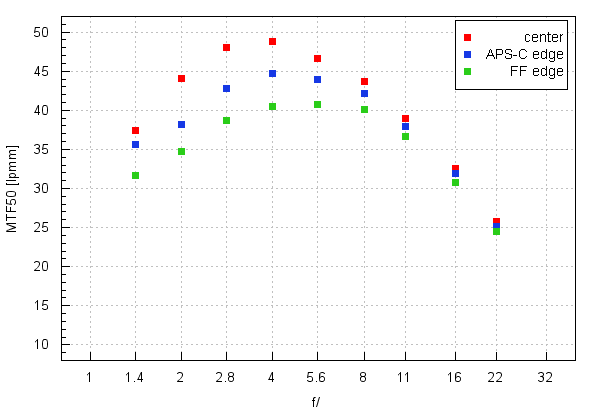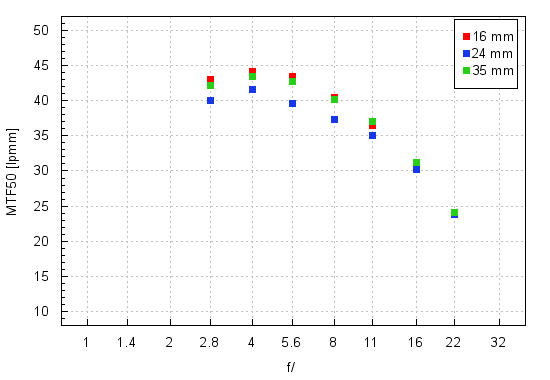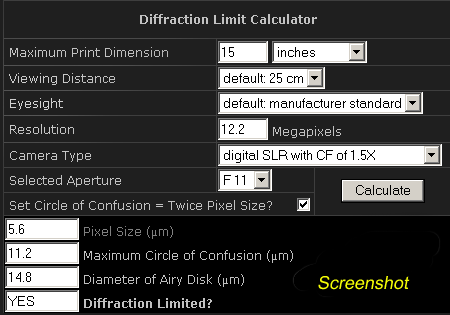M
Marek M
Guest
I've read about it a bit but still am unsure what the function of "Diffraction Correction" setting does in practice.
Could someone who knows explain, please?
Could someone who knows explain, please?
Follow along with the video below to see how to install our site as a web app on your home screen.
Note: This feature may not be available in some browsers.
What I am really asking about, is the effect on the picture. What difference will/should there be?The diffraction error that reaches the sensor will be different for every camera - lens pairing depending on the aperture blade shape and the low pass filter setup.
I don't know if they model or measure the pattern of the error, but whichever it is they can then apply a profile that adds or subtracts what the diffraction subtracted or added for each pixel of the final image.
Given some information about the lens and the known quantity of a given sensor, there is a sharpening function which can sharpen the diffraction out of an image. This is used to sharpen images taken at F/stops from F/8 and slower through whatever the lens can manage.I've read about it a bit but still am unsure what the function of "Diffraction Correction" setting does in practice.
Could someone who knows explain, please?
Thank you for the explanation.Given some information about the lens and the known quantity of a given sensor, there is a sharpening function which can sharpen the diffraction out of an image. This is used to sharpen images taken at F/stops from F/8 and slower through whatever the lens can manage.I've read about it a bit but still am unsure what the function of "Diffraction Correction" setting does in practice.
Could someone who knows explain, please?
If it works, it will be subtle like a gentle hand on the sharpen controls of DPP or photoshop.
Just set it to OFF (factory default)I hardly ever get to f8 and above , would it then mean that keeping "Diffraction correction" on be irrelevant?
Yeah, not that low pass filter set up. Just the lens, and for how they want to correct it the pixel pitch.The diffraction error that reaches the sensor will be different for every camera - lens pairing depending on the aperture blade shape and the low pass filter setup.
I don't know if they model or measure the pattern of the error, but whichever it is they can then apply a profile that adds or subtracts what the diffraction subtracted or added for each pixel of the final image.
Diifraction correction is also known as "deconvolution". With mathematical models it is possible to recreate some detail that appears to be lost in soft areas, softness resulting from diffraction of light for instance.I've read about it a bit but still am unsure what the function of "Diffraction Correction" setting does in practice.
Could someone who knows explain, please?
No it isn't. How did you come by that f9.3 figure? Different wavelengths of light diffract differently. You already can measure lesser sharpness with normal light past f4 with a 6D, so also with a 6D mk II which has a smaller pixel pitch.Diffraction limited aperture for your 6DII is f9.3.
That's the aperture at which stopping down no longer produces a sharper image and begins to soften the image, but diffraction should still be negligible at f11. It shouldn't really matter whether you leave it on or off unless you want to shoot f16 or f22.
The Diffraction Limit: point at which selecting a smaller aperture (all else being equal) starts to diminish sharpness by minimizing lens aberrations.No it isn't. How did you come by that f9.3 figure? Different wavelengths of light diffract differently.Diffraction limited aperture for your 6DII is f9.3.
So far, no nonsense.The Diffraction Limit: point at which selecting a smaller aperture (all else being equal) starts to diminish sharpness by minimizing lens aberrations.No it isn't. How did you come by that f9.3 figure? Different wavelengths of light diffract differently.Diffraction limited aperture for your 6DII is f9.3.
DOF is expressed with viewing distance and print size in mind.When using an online calculator (or the formula directly) to determine the Diffraction Limit...most assume light in the middle of the visible spectrum and use a wavelength of ~550 nm. Given that, the f9.3 number seems about right with a 10 inch print and close viewing distance (inside 20cm or so). Change the Viewing distance and/or print size and limit changes...of course



DoF is not a variable in the Diffraction Limit calculation...but viewing distance and print size are as it relates to CoCSo far, no nonsense.The Diffraction Limit: point at which selecting a smaller aperture (all else being equal) starts to diminish sharpness by minimizing lens aberrations.No it isn't. How did you come by that f9.3 figure? Different wavelengths of light diffract differently.Diffraction limited aperture for your 6DII is f9.3.
DOF is expressed with viewing distance and print size in mind.When using an online calculator (or the formula directly) to determine the Diffraction Limit...most assume light in the middle of the visible spectrum and use a wavelength of ~550 nm. Given that, the f9.3 number seems about right with a 10 inch print and close viewing distance (inside 20cm or so). Change the Viewing distance and/or print size and limit changes...of course
You asked were the "Diffraction limited aperture for your 6DII is f9.3" came from. I explained it as it relates to the normal Diffraction Limit Calculation most use. MTF tests are a bit apples to oranges regards the math as they use a different set of calculations and variables to derive the MTFThese MTF tests are done with a normal "white" light spectrum and using a normal RBG imaging sensor with Bayer CFA.
No, that is not true. CoC related to DOF indeed is viewing distance and print size dependent.DoF is not a variable in the Diffraction Limit calculation...but viewing distance and print size are as it relates to CoCSo far, no nonsense.The Diffraction Limit: point at which selecting a smaller aperture (all else being equal) starts to diminish sharpness by minimizing lens aberrations.No it isn't. How did you come by that f9.3 figure? Different wavelengths of light diffract differently.Diffraction limited aperture for your 6DII is f9.3.
DOF is expressed with viewing distance and print size in mind.When using an online calculator (or the formula directly) to determine the Diffraction Limit...most assume light in the middle of the visible spectrum and use a wavelength of ~550 nm. Given that, the f9.3 number seems about right with a 10 inch print and close viewing distance (inside 20cm or so). Change the Viewing distance and/or print size and limit changes...of course
And explained that that is incorrect.You asked were the "Diffraction limited aperture for your 6DII is f9.3" came from.These MTF tests are done with a normal "white" light spectrum and using a normal RBG imaging sensor with Bayer CFA.
I explained it as it relates to the normal Diffraction Limit Calculation most use. MTF tests are a bit apples to oranges regards the math as they use a different set of calculations and variables to derive the MTF
Look at the formulas for Diffraction Limit at ~550 nm. You will find no DoF variableNo, that is not true. CoC related to DOF indeed is viewing distance and print size dependent.DoF is not a variable in the Diffraction Limit calculation...but viewing distance and print size are as it relates to CoCDOF is expressed with viewing distance and print size in mind.


You are the one confusing DOF and diffraction, not me.Look at the formulas for Diffraction Limit at ~550 nm. You will find no DoF variableNo, that is not true. CoC related to DOF indeed is viewing distance and print size dependent.DoF is not a variable in the Diffraction Limit calculation...but viewing distance and print size are as it relates to CoCDOF is expressed with viewing distance and print size in mind.
Examples:


diffraction limit depends on the pinhole radius, ro. It is defined by the angle Δθ = t0λ/2πro where t0 = 3.832
I never brought up DoF and as you can see...it is not a variable in the calculation of Diffraction LimitYou are the one confusing DOF and diffraction, not me.Look at the formulas for Diffraction Limit at ~550 nm. You will find no DoF variableNo, that is not true. CoC related to DOF indeed is viewing distance and print size dependent.DoF is not a variable in the Diffraction Limit calculation...but viewing distance and print size are as it relates to CoCDOF is expressed with viewing distance and print size in mind.
Examples:


diffraction limit depends on the pinhole radius, ro. It is defined by the angle Δθ = t0λ/2πro where t0 = 3.832
You brought up print size and viewing distance, which ARE about DOF and not about diffraction.I never brought up DoF and as you can see...it is not a variable in the calculation of Diffraction LimitYou are the one confusing DOF and diffraction, not me.Look at the formulas for Diffraction Limit at ~550 nm. You will find no DoF variableNo, that is not true. CoC related to DOF indeed is viewing distance and print size dependent.DoF is not a variable in the Diffraction Limit calculation...but viewing distance and print size are as it relates to CoCDOF is expressed with viewing distance and print size in mind.
Examples:


diffraction limit depends on the pinhole radius, ro. It is defined by the angle Δθ = t0λ/2πro where t0 = 3.832
Yes as they are variables in the Diffraction Limit calculationYou brought up print size and viewing distance,I never brought up DoF and as you can see...it is not a variable in the calculation of Diffraction Limit
and DoF is not a variable in that calculation. Apples and oranges. As an example, subject distance is not needed to calculate the Diffraction Limitwhich ARE about DOF and not about diffraction.
we are speaking about how the Diffraction Limit is derived (f9,3 in this case)...not how the DoF number is derived. As an example, subject distance is not needed to calculate the Diffraction LimitExamples:


diffraction limit depends on the pinhole radius, ro. It is defined by the angle Δθ = t0λ/2πro where t0 = 3.832
